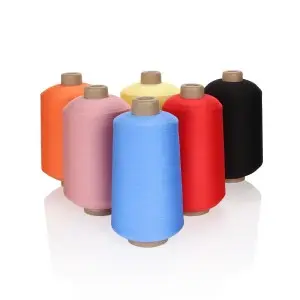Polyester hot-melt yarn is mixed with ordinary polyester or other fibers to produce non-woven fabrics or knitted or woven into thermally bonded fiber products, which have the characteristics of soft hand, high strength, washability, crispness, easy care, and no environmental pollution.
Purpose of polyester hot melt yarn: It mainly plays the role of thermal bonding and is used in Bondi thread weaving, high-strength webbing, wool carpets, cushions, automobile linings and other industries.
⒈Good wear resistance. The wear resistance is second only to nylon, which has better wear resistance, and is better than other natural fibers and synthetic fibers.
⒉Good thermoplasticity but poor melt resistance. Because the surface of polyester is smooth and the internal molecules are tightly arranged, polyester is a fabric with better heat resistance among synthetic fabrics. It is thermoplastic and can be made into pleated skirts. At the same time, polyester fabric has poor melt resistance and can easily form holes when exposed to soot, sparks, etc. Therefore, you should try to avoid contact with cigarette butts, sparks, etc. when wearing it。
⒊Heat-resistant polyester is made by melt spinning. The formed fibers can be heated and melted again to become thermoplastic fibers. The melting point of polyester is relatively high, but the specific heat capacity and thermal conductivity are small, so the heat resistance and insulation of polyester fiber are higher. It is the best among the fibers.
⒋Good elasticity. The elasticity is close to wool, and it can almost recover when stretched by 5% to 6%. The wrinkle resistance is better than other fibers, that is, the fabric does not wrinkle and has good dimensional stability. The elastic modulus is 22~141cN/dtex, which is 2~3 times higher than nylon. .Polyester fabric has high strength and elastic recovery ability, so it is strong and durable。
⒌High strength. The strength of short fiber is 2.6~5.7cN/dtex, and the strength of high-strength fiber is 5.6~8.0cN/dtex. Because of its low hygroscopicity, its wet strength is essentially the same as its dry strength. The impact resistance is 4 times higher than nylon and 20 times higher than viscose fiber.
Post time: Jul-22-2024

